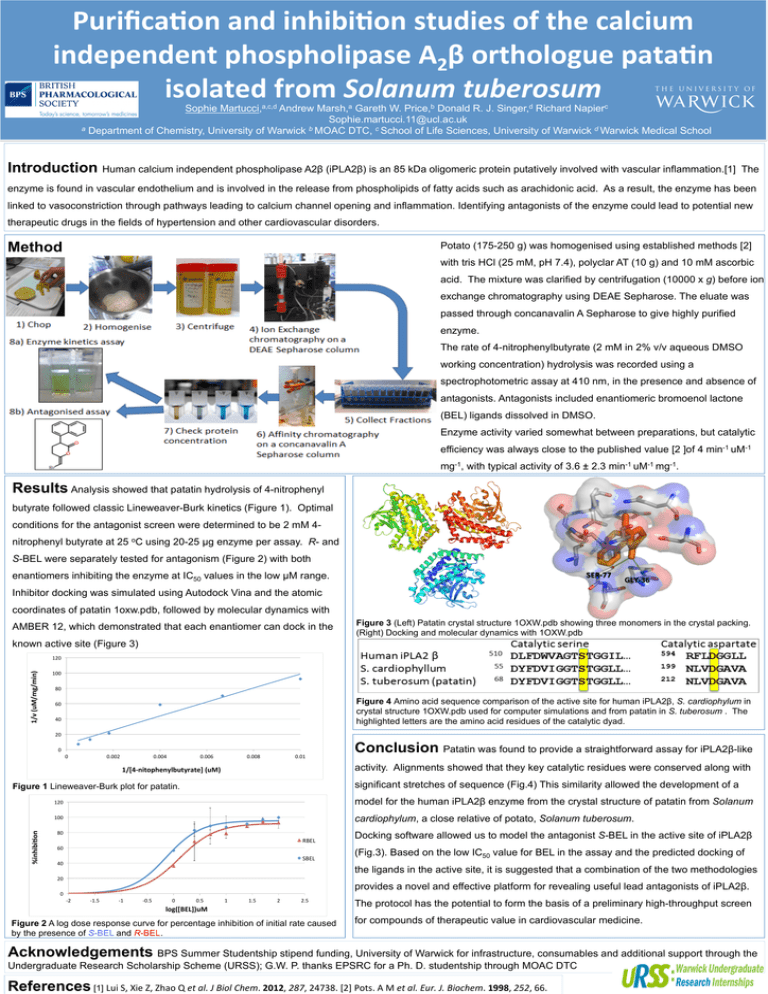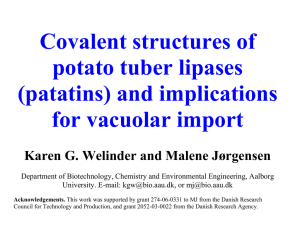Document 13186207
advertisement

Purifica>on and inhibi>on studies of the calcium independent phospholipase A2β orthologue pata>n isolated from Solanum tuberosum Sophie Martucci,a,c,d Andrew Marsh,a Gareth W. Price,b Donald R. J. Singer,d Richard Napierc Sophie.martucci.11@ucl.ac.uk a Department of Chemistry, University of Warwick b MOAC DTC, c School of Life Sciences, University of Warwick d Warwick Medical School Introduction Human calcium independent phospholipase A2β (iPLA2β) is an 85 kDa oligomeric protein putatively involved with vascular inflammation.[1] The enzyme is found in vascular endothelium and is involved in the release from phospholipids of fatty acids such as arachidonic acid. As a result, the enzyme has been linked to vasoconstriction through pathways leading to calcium channel opening and inflammation. Identifying antagonists of the enzyme could lead to potential new therapeutic drugs in the fields of hypertension and other cardiovascular disorders. Method Potato (175-250 g) was homogenised using established methods [2] with tris HCl (25 mM, pH 7.4), polyclar AT (10 g) and 10 mM ascorbic acid. The mixture was clarified by centrifugation (10000 x g) before ion exchange chromatography using DEAE Sepharose. The eluate was passed through concanavalin A Sepharose to give highly purified enzyme. The rate of 4-nitrophenylbutyrate (2 mM in 2% v/v aqueous DMSO working concentration) hydrolysis was recorded using a spectrophotometric assay at 410 nm, in the presence and absence of antagonists. Antagonists included enantiomeric bromoenol lactone (BEL) ligands dissolved in DMSO. Enzyme activity varied somewhat between preparations, but catalytic efficiency was always close to the published value [2 ]of 4 min-1 uM-1 mg-1, with typical activity of 3.6 ± 2.3 min-1 uM-1 mg-1. Results Analysis showed that patatin hydrolysis of 4-nitrophenyl butyrate followed classic Lineweaver-Burk kinetics (Figure 1). Optimal conditions for the antagonist screen were determined to be 2 mM 4nitrophenyl butyrate at 25 oC using 20-25 µg enzyme per assay. R- and S-BEL were separately tested for antagonism (Figure 2) with both SER-­‐77 enantiomers inhibiting the enzyme at IC50 values in the low µM range. GLY-­‐36 Inhibitor docking was simulated using Autodock Vina and the atomic coordinates of patatin 1oxw.pdb, followed by molecular dynamics with AMBER 12, which demonstrated that each enantiomer can dock in the Figure 3 (Left) Patatin crystal structure 1OXW.pdb showing three monomers in the crystal packing. (Right) Docking and molecular dynamics with 1OXW.pdb known active site (Figure 3) 1/v (uM/mg/min) 120 100 80 Figure 4 Amino acid sequence comparison of the active site for human iPLA2β, S. cardiophylum in crystal structure 1OXW.pdb used for computer simulations and from patatin in S. tuberosum . The highlighted letters are the amino acid residues of the catalytic dyad. 60 40 20 0 0 0.002 0.004 0.006 0.008 0.01 activity. Alignments showed that they key catalytic residues were conserved along with 1/[4-­‐nitophenylbutyrate] (uM) significant stretches of sequence (Fig.4) This similarity allowed the development of a Figure 1 Lineweaver-Burk plot for patatin. %inhibi>on Conclusion Patatin was found to provide a straightforward assay for iPLA2β-like 120 model for the human iPLA2β enzyme from the crystal structure of patatin from Solanum 100 cardiophylum, a close relative of potato, Solanum tuberosum. 80 RBEL 60 SBEL 40 Docking software allowed us to model the antagonist S-BEL in the active site of iPLA2β (Fig.3). Based on the low IC50 value for BEL in the assay and the predicted docking of the ligands in the active site, it is suggested that a combination of the two methodologies 20 provides a novel and effective platform for revealing useful lead antagonists of iPLA2β. 0 -­‐2 -­‐1.5 -­‐1 -­‐0.5 0 0.5 1 1.5 2 2.5 log([BEL])uM Figure 2 A log dose response curve for percentage inhibition of initial rate caused by the presence of S-BEL and R-BEL. The protocol has the potential to form the basis of a preliminary high-throughput screen for compounds of therapeutic value in cardiovascular medicine. Acknowledgements BPS Summer Studentship stipend funding, University of Warwick for infrastructure, consumables and additional support through the Undergraduate Research Scholarship Scheme (URSS); G.W. P. thanks EPSRC for a Ph. D. studentship through MOAC DTC References [1] Lui S, Xie Z, Zhao Q et al. J Biol Chem. 2012, 287, 24738. [2] Pots. A M et al. Eur. J. Biochem. 1998, 252, 66.



